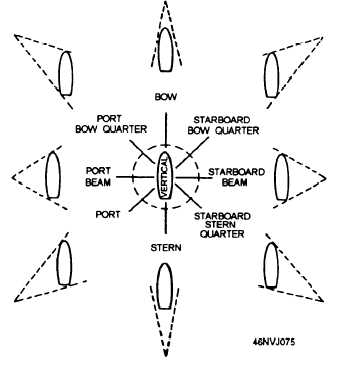The value of maritime surveillance photography
can be enhanced if you use correct photographic
composition, appropriate field of view, and proper
rigging patterns (fig. 4-28). The best photographic
composition of a ship cannot always be obtained by
shooting horizontal views. In maritime surveillance
photography, it is important for you to ensure the target
is recorded as large as possible on film.
Four basic rigging patterns for maritime
surveillance photography arc in use today. They are the
Special Interest Rig, the Quick Rig, the Normal
Standard Rig, and the Full Rig. Proper rigging of the
target provides maximum intelligence data from the
photographs. To better understand the purpose of each
rig, you must know what each view (or point) of the rig
is designed to achieve. The BOW QUARTER view is
useful in determining forward deck cargo-handling
equipment, electronic arrays, and vessel identification.
The BEAM view provides the length of the target plus
the stack and antenna height. The STERN QUARTER
and the STERN views are used to determine cargo and
electronic arrays on the aft section of the vessel. The
VERTICAL view is valuable in locating electronic
arrays, in determining full-deck cargo, and for
measurement purposes.
Figure 4-28.—Maritime surveillance photography rigging
patterns.
The SPECIAL INTEREST RIG is required when a
particular vessel is photographed for the first time, or
there are specific areas of interest on a particular vessel.
Before this type of mission, a special briefing must be
conducted to determine what specific rigs should be
flown to satisfy mission requirements. The QUICK
RIG is used for routine photographic documentation of
a contact (vessel) observed while on patrol. The quick
rig consists of the bow quarter, beam, and stem quarter
views of a vessel. The NORMAL STANDARD RIG,
commonly referred to as the FIVE POINT RIG, consists
of the bow quarter, beam, stem quarter, stem, and
vertical views of a vessel. This rig is used to provide a
more detailed representation of a vessel. The FULL
RIG, or NINE POINT RIG, is required when enemy or
potential enemy vessels are being photographed. This
rig provides complete coverage for all the areas of
interest. The best approach for rigging most of the
aircraft used in maritime surveillance photography is
from the bow of the target.
Although the previous discussion concerns
obtaining intelligence photography, the very same
procedures are useful in shooting pictures of ships and
submarines for PA0 release and for display prints. By
using these procedures, you can "kill two birds with one
stone." You get the display pictures, and it serves as a
training mission in maritime surveillance photography
for both you and the pilot.
MOTION-MEDIA PHOTOGRAPHY
FROM THE AIR
In most cases, the techniques and exposure
recommendations for still aerial photography apply to
shooting motion-media photography from the air.
However, there are a few differences. As a general rule,
frames-per-second (fps) rates that are above normal
should be used for motion pictures; that is, unless you
have a specific requirement to film at the "real time"
rate. Just as in still photography, the image quality of
aerial motion media suffers from image motion on the
recording. Motion-media scenes taken from aircraft
always appear much faster when viewed than when they
were being recorded originally. Aerial movies when
shown at normal frame rates are disturbing to the
viewer. There is no hard-and-fast rule about what frame
rate is appropriate for viewing; there are several factors
that play a significant role, such as speed and altitude of
the aircraft. A general rule of thumb is to use about one
and one half or twice the normal frame rate: 32 to 48
frames per second for 16mm and 24 to 36 frames per
4-34


